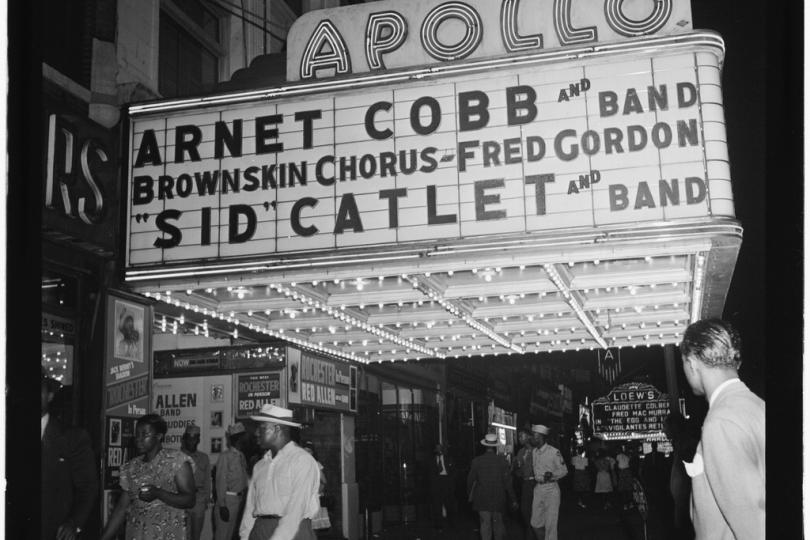The Harlem Renaissance

The Round Table had a specific location to convene, but the other New York Art Movement known as the Harlem Renaissance gathered in various locales, including The Cotton Club. This movement focused on new expressions offset by the postwar (WWI) Great Migration, so admirably documented by artist Jacob Lawrence in his book of the same name. This migration brought African Americans north and to the Midwest seeking improved lives and less racism. New York’s Harlem was a good place to settle, because it featured beautiful homes, avenues, polo grounds and several entertainment venues, including an Opera House It’s generally noted that the movement began when, in 1917, Caucasian playwright Ridgely Torrence produced Three Plays for a Negro Theater, which featured new ideas that inspired others. This led to the remarkable Harlem Renaissance!
Shuffle Along
Last year on Broadway, director George C. Wolfe (Angels in America) and his collaborators presented a revisal Shuffle Along, the first African American musical to play a long run on Broadway. Starring Brian Stokes Mitchell, Audra McDonald and Billy Porter, it told about the creation of this pioneering work with its sensational score by Eubie Blake and Noble Sissle. However, like the original production, this was a troubled show (the night I saw it, in previews, the second act needed considerable reworking), but the energy of the performers and Savion Glover’s lively choreography made this a pleasure anyway.
It closed due to Ms. McDonald pregnancy. Instead, it may have been wiser to go on hiatus, work out the kinks and when she was ready to return, continue the run. Hopefully, this superb addition to modern musicals and classic revivals will return.
Jazz and Ragtime
Both of these musical styles were born in Harlem. If you need a crash course on the incredible music and the artists who created it, there are original cast albums that celebrate the more famous music maker of the time. In 1978, Ain’t Misbehavin’, a revue of Fats Waller’s music, won the Tony for Best Musical. In years to follow, Eubie! honored Eubie Blake, and at the age of 100, he himself appeared onstage performing his hits including “I’m Just Wild About Harry.” The music and life of Jelly Roll Morton became the source for Jelly’s Last Jam, and Sophisticated Ladies celebrated the great Duke Ellington. Another musical, Bubbling Brown Sugar, honors some of the great performers, some listed below, such as Adelaide Hall and Florence Mills.
This is not to say that the jazz and ragtime were only famous in the theater. Clubs featured pianists who played in the Harlem Stride style, enhanced by Louis Armstrong’s trumpet, the Scat sounds of Cab Calloway, blues from “Ma” Rainey and Bessie Smith or the charms of Ethel Waters. The classical sounds of William Grant Still were heard in concert halls and the Opera.
Adelaide Hall’s 70 year career began with Shuffle Along, but not in the USA. Her fame grew when she led the original London production. She holds the Guinness Book Record for most enduring recording artist. Hall recorded with Louis Armstrong, Cab Calloway and Fats Waller. Her most famous recording, “Creole Love Call” was made with Duke Ellington.
Florence Mills was known as the “Queen of Happiness because of her sparkling persona, her gentle voice and charismatic beauty.
Ma Rainey is often credited as the earliest professional blues singer and is the Mother of the Blues. Ma Rainey was the mentor of Bessie Smith.
Bessie Smith was known as the Empress of the Blues. She was the most popular blues singer of the 20s and 30s and has influenced many others. Sadly, she died after a car accident in Mississippi because no white hospital would admit her. She was buried in an unmarked grave until 1970, when Janis Joplin paid for a headstone. Queen Latifah played her in a superb television movie recently.
Ethel Waters was a powerhouse performer. A recording artist, stage and screen star, the second African American Oscar nominee (Pinky) and one of the first actresses to star in a television series (Beulah), her hit recordings include ‘Stormy Weather,” “Suppertime,” and “Takin’ a Chance on Love” from Cabin in the Sky.
Known as the First Lady of Song, Ella Fitzgerald began her career in Harlem with Chick Webb and his Orchestra, but following her rendition of “A Tisket, A Tasket,” her career was off and running. Among her great hits are “Dream a Little Dream of Me,” “It Don’t Mean a Thing (if it Ain’t Got that Swing!) and she has covered the Gershwin, Cole Porter, Rodgers and Hart, Irving Berlin and Duke Ellington Songbooks. She won 14 Grammy Awards, the National Medal of Arts and the Presidential Medal of Freedom. She passed on in 1993 at the age of 79.
Theater
In the theater, audiences thrilled to the dancing of the remarkable Bill “Bojangles” Robinson and the routines of comedian Bert Williams. An All-American football player, Paul Robeson had a strong voice, which audiences first heard in a pair of Eugene O’Neill plays: The Emperor Jones and All God’s Chillun Got Wings. He created the role of Joe in the original production of Show Boat, and his performance was captured in the 1936 film version. Robeson was also a political activist, but was blacklisted during the McCarthy Era. He achieved world fame as a singer and for his performance as Othello, however, he became a recluse as his health declined. He passed on in 1976 at the age of 77.
Bill “Bojangles” Robinson, “Mr. Bojangles,” had a career that predates the Harlem Renaissance. Starting in minstrel shows, he performed in vaudeville, on Broadway, Hollywood, radio and TV. He is credited with introducing the word copacetic into popular culture. Best known for his stair dance, he’s probably best known for his dancing with Shirley Temple, and for Stormy Weather, a film loosely based on his own life. Robinson often broke rules and helped establish new ones for performers of color. The highest paid African American performer of his era, he died penniless, although he was remembered as a great influence for Fred Astaire, Lena Horne, The Nicholas Brothers, Sammy Davis, Jr., Ann Miller and Gregory Hines, who starred a biographical film about Robinson. His birthday, May 25, is National Tap Dance Day.
A young lady from St. Louis, Josephine Baker, daringly wrapped a skirt made from oversized cloth bananas, danced a wild Charleston, and became the toast of Paris, where she was known as “le Jazz Hot.” Indeed, many of these performers found fame and popularity in Europe where she starred with the Folies Bergere. Baker was the muse of couturier Jean Patou and her clothes were often imitated. Vogue magazine found her look "startling.” Baker was a tireless worker and spy for the French Resistance and was awarded the Legion of Honor. Refusing to perform where racial segregation was practiced, she toured the world, and in later years raising her “Rainbow Tribe” of 12 adopted children, settled in Monaco at the invitation of Princess Grace. She died in 1975.
Jackie “Moms” Mabley is among the first women to break into the world of comedy. Born Loretta Mary Aiken, she was the victim of violence and tragedy early in her life. Taking the advice of her grandmother, she moved North, and began working the circuit. She was also one of the first openly gay comediennes. She appeared with Paul Robeson in the film version of The Emperor Jones, and at the height of her career, earned $10,000 a week, playing theaters like Harlem’s Apollo Theater. In the 1960s, appearances on the Smothers Brothers TV show and an engagement at Carnegie Hall brought her to a larger audience. Mabley didn’t do routines. She found her comedy in topical subjects: racism, romance and politics. Wearing the costume of a disheveled woman in a house dress and floppy hat, she’s a treasure, which is obvious in the documentary film, Whoopi Goldberg presents Moms Mabley, which was shown on HBO and is available on disc. She had great success late in life with her rendition of “Abraham, Martin and John” at the age of 75, making her the oldest living American with a hit record. She passed on from heart failure in 1975.
Writers
When I was in college, I saw Charles Gordone’s Pulitzer Prize-winning play No Place to Be Somebody at Milwaukee’s beautiful Pabst Theater. A quote from Harlem Renaissance poet Countee Cullen was among the program notes and in researching this article, I learned that Cullen was one of its leading writers. Langston Hughes (Black Nativity), Zora Neale Hurston (Their Eyes Were Watching God) and Georgia Douglas Johnson, whose play Plumes is among the few plays by African American women during this period.
While this is clearly an overview and there’s so much more to write about. The Harlem Renaissance helped to lay the foundation for the protests that led to the Civil Rights Movement. The works of these composers, performers, authors and painters told the stories of these extraordinary pioneers in our literary history.




